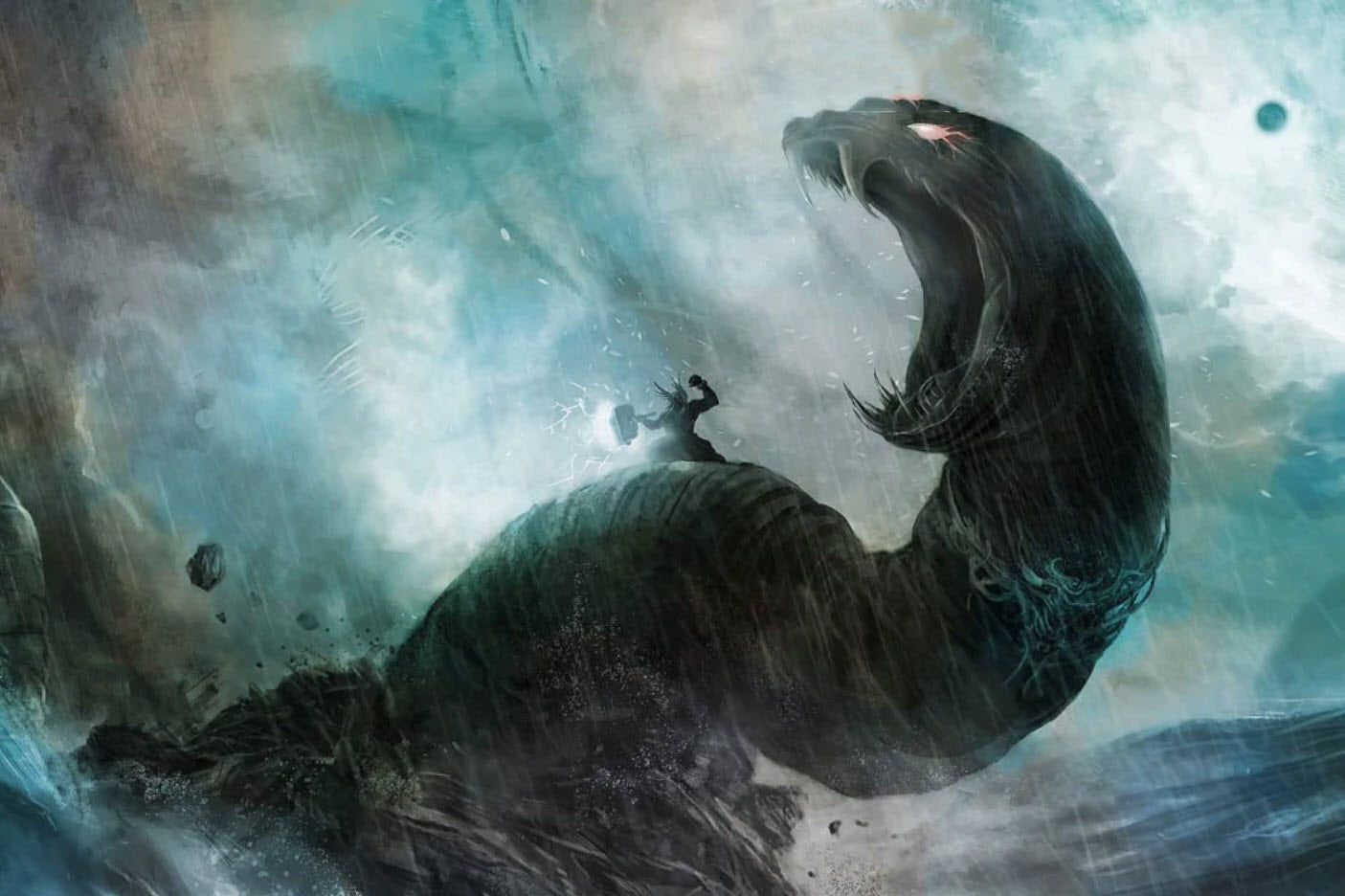Jormungandr, The Midgard World Serpent
In Norse mythology Jörmungandr (Old Norse: Jǫrmungandr, pronounced "yormun-gan-drah", sometimes anglicized to Jormungand or Worm of Midgard) is the middle child of the giantess Angrboða and Loki. Its role was to keep guard over the mist-covered island where the gods lived, telling warning them of any dangers to come, later they would build fortresses and palaces in anticipation of fighting this serpent. According to Norse mythology, it was Ragnarök when this serpent would finally be slain by Thor with his mace Mjölnir.
The origin of Jormungandr
The origin of Jormungandr is a tale of two myths. In the Elder Edda, the Kraken is created by Loki in a fit of anger. After the gods bestow various gifts on Loki, they ask him what he wants in return. Loki says that he wants to have a long life, good health and wealth. The gods grant his wish but not without a catch - he will be bound in a cave with venom dripping from his face.
The other myth comes from Norse mythology and it involves Thor's fishing trip with the giant Hymir. During this trip, Thor catches Jormungandr (the Midgard Serpent) on his line and brings him back to shore as proof that he has caught the largest fish in all of Midgard (the seas surrounding Earth). Thor's father Odin names the serpent Jormungandr which means "huge monster" or "huge serpent" and tells Thor to kill it before releasing it back into Midgard.
Is Jörmungandr good or evil?
Jörmungandr is a giant sea serpent, which means there are a lot of ways to interpret how it relates to good or evil. It's big, so that's scary and evil, right? Well, maybe that's the case if you're a person who likes to live on land and would like to stay out of the ocean—but in Norse mythology, the sea held just as much importance as the land. It could be argued that Jörmungandr is a protector of the sea and all its creatures.
Jörmungandr is a child of Loki, who most people recognize as evil based on his trickery throughout other myths—but this may not mean anything about Jörmungandr itself. In fact, Loki himself could have been considered evil in one instance because he was helping to get rid of an animal that killed people (the wolf Fenrir), but then he was considered good for doing something nice for Odin when he helped him recover his stolen speech. So from this example we can see that in Norse mythology, there are no clear lines between what is evil and what is good.
Why is Jörmungandr called the world serpent?
Jormungand was one of the most powerful creatures in Norse mythology, and he was said to be so powerful that he encircled the entire Earth underneath the oceans, from his tail to his head, creating a great serpent. In some versions of the story, Jormungand fought with Thor for nine days and nights before being thrown into the ocean by Odin.
Jormungand was said to have grown so large that it could encircle the entire world (Midgard). In some versions of the story, Jormungand fights with Thor for nine days and nights before being thrown into the ocean by Odin.
The name “Jörmungandr” means “huge monster.” The word “jörmungr” itself is related to the words for “earth” or “soil” in Icelandic, Swedish and Norwegian languages.
How did Jörmungandr grow so big?
There are several theories about how Jörmungandr got so large. The first is that he grew from venom dripping from the fangs of another Norse monster, Fenrir, who was a wolf huge enough to swallow the sun whole. Another theory is that he grew from venom that dripped from the World Serpent's mouth as it lay in the Well of Wyrd during Ragnarök. There's a third theory that Jörmungandr came into existence when poison rising from Niflheim, one of the nine realms of Norse mythology, coated the malevolent worm called Miðgarðsormr, who then turned into Jörmungandr.
Why did Odin throw Jörmungandr into the ocean?
Ancient Norse mythology doesn't give a clear reason, but there are places where it can be found hinted at. One of the most prevalent interpretations is that he only did it to keep him from causing damage on land. In one source,
It was said by the old ones that if this snake would get loose from Asgard, it would reach all the way around the Earth and bite his own tail, and this is a great Midgard serpent, and lies there in the ocean which encircles the land; and he may lie there, I believe, till the end of the world.
Honoring fear as a motivator, this could have been Odin's way of stopping Jörmungandr from running amok—if he couldn't be hurt by any weapon or god, then his only weakness would be away from land. But if he couldn't be killed by anyone else, why would Odin bother doing it himself? It's possible that Odin simply didn't want to risk Jörmungandr getting out of hand while he was sleeping with one eye open watching over Midgard and protecting humans.
Why did Thor hate Jörmungandr?
Is it possible that he was just jealous of all the attention that this giant sea-serpent was getting from his dad? Could it be because Jörmungandr is actually an evil counterpart to Thor—one that he must kill at the end of Ragnarok, the Norse apocalypse myth? This makes sense: unlike Thor and his family, who are all gods, Jörmungandr is an actual being created by Loki, one of the tricksters in Norse mythology. Loki's evil nature (which also includes creating Fenrir and Hel) was contained in Jörmungandr's very creation—he wanted to make something so horrible that no one would ever dare release him from his prison again.
Thor knew this, which is why he hated Jörmungandr so much. He could never see Jörmungandr as anything other than what he was: a monster that must be killed. But Odin saw things differently. He recognized a tragic duality in Jörmungandr—one that both mirrored and contrasted with himself. Odin knew about Loki's trickery and realized the futility of trying to kill him, But he also hoped for a time when he could forgive his son for his actions.
Who is stronger Fenrir or Jörmungandr?
When it comes to strength, Fenrir has an edge over Jörmungandr. Fenrir was so strong that he was able to break free from his chains and kill his own brother Hati Hróðvitnisson (the giant wolf chasing the sun). He also killed Tyr's hand when Tyr tried to feed him bread with it.
In contrast, Jörmungandr was defeated by Thor in battle after Thor cast a spell on himself that made him stronger than ever before so that he could defeat this deadly serpent who had been growing larger every day since he had first been cast into the sea
Does Jörmungandr cause Ragnarök?
whenever Jörmungandr moves, earthquakes occur. Some people think he may have something to do with Ragnarök, or the Norse version of the apocalypse. According to legend, Ragnarök will be preceded by three winters without summers in between. It's said that a wolf called Skoll will catch the sun and swallow it, causing darkness to fall over the world for a very long time. Jörmungandr's movements may be causing these earthquakes, which could be interpreted as a sign that an apocalypse is coming.
Where do we get this idea? Well, one of the prophecies about Ragnarök says that Jörmungandr will come across land and sea to meet an enemy (likely Thor) in a final showdown. This certainly supports our hypothesis: Jörmungandr is moving around so much because he's looking for Thor. But there are other parts of the prophecy that don't seem to line up: it says that Thor will meet his death in this fight with Jörmungandr, but then we're told that everything goes back to normal afterward—the Earth recovers from the damage caused.
What does Jormungandr symbolize
The Jörmungandr symbol represents the desire to have life after death, or in other words, the hope for an afterlife. The serpent Jörmungandr is also a symbol of rebirth, which could be a reference to how it has been said that the snake sheds its skin and is reborn every year. It is also possible that Jörmungandr symbolizes the cycle of life, because it continuously consumes itself and is reborn.
Conclusion
While the existence of Jormungandr is open to interpretation, be it mythological or not, the impact that this serpent has had on the consciousness of humanity is undeniably indelible. Whether you take a look at ourselves in mythology and ancient history and see in our depictions of serpents a mirror into what humanity has been throughout history, or if you can embrace this snake as part of Norse mythos, there is no denying that Jormungandr will remain a noteworthy piece of human history for years and decades to come.




Leave a comment